In this article
Choosing the right kids hiking boots feels like a high-stakes gamble; you’re caught between the fear of wasting money on shoes they’ll quickly outgrow and the anxiety of a ruined outdoor adventure due to blisters and discomfort. It’s a classic conflict between the pragmatic parent and the dedicated hiker who understands the value of quality gear. This decision deserves more than a quick scroll through top-10 lists populated by bots. It requires a genuine framework for making a confident, defensible choice.
This guide is designed to provide exactly that. We will transform you into an expert on your own child’s needs, moving beyond generic recommendations to build a clear decision-making process.
- First, we will establish your educational foundation, explaining the non-negotiable features of a quality kids’ hiking boot, from a podiatrist’s perspective.
- Then, we’ll pull back the curtain on our rigorous field-testing process, recommending specific durable shoes that excel for different types of young adventurers and explaining, in detail, exactly why they earned their spot.
What Truly Matters in a Kids Hiking Boot?
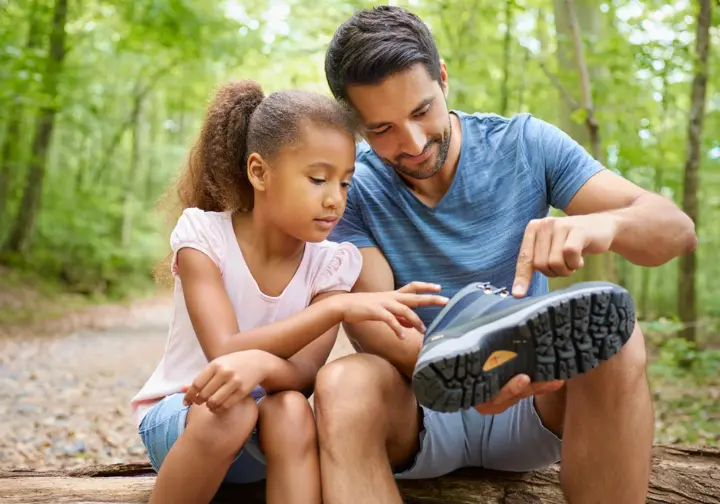
This section will arm you with the essential knowledge to confidently evaluate any kids’ hiking boot and understand the critical trade-offs between features. Armed with this framework, you can move past marketing claims and focus on the attributes that ensure your child’s safety, comfort, and enjoyment on the trail.
Why is a Podiatrist’s Perspective the Best Starting Point?
Before we even look at a single boot, we must start with the foot itself. A child’s feet are not miniature adult feet; they’re a dynamic structure in a constant state of development. The wrong footwear at a critical stage can do more harm than good. That’s why we ground our philosophy in podiatric science. For toddlers and early walkers, flexibility is paramount. A flexible sole is not a sign of a cheap shoe; it’s a critical feature that allows the foot to feel the ground, providing essential sensory feedback for developing balance and muscle strength. You should also be wary of the myth of artificial arch support.
A child’s arch develops naturally, and aggressive, built-in support can interfere with that process. True support comes from a well-constructed heel counter and a snug fit. Finally, look for a boot with a wide toe box. Children’s feet are often wider than adults’, and they need ample room for their toes to splay and grip, a natural motion essential for maintaining balance. These principles of fit and function are crucial for hikers of all ages, as detailed in our complete guide to choosing hiking boots. Ultimately, as leading podiatrists advise in their guide to buying children’s footwear, respecting the natural foot development is the most important first step.
How Critical is Traction for a Child’s Safety?
Traction is a non-negotiable safety feature, period. On a trail, the terrain is unpredictable—shifting from solid ground to loose scree, slick mud, or wet rocks in a matter of steps. This is where the aggressive tread of a real hiking shoe offers a measurable safety advantage over the flatter, less-defined soles of typical sneakers. Hiking-specific outsoles armed with deep, multi-directional lugs are engineered to bite into varied surfaces, providing the grip needed on slippery trail surfaces to prevent the slips that can lead to falls and other trail hazards. The stakes are high; a study on mountain hiking accidents revealed that falls are a primary cause of injury. A boot with excellent traction is a parent’s first and best line of defense against those incidents. While traction prevents falls, a proper fit is essential to stop blisters in their tracks, addressing both external and internal safety.
Does My Child Really Need Ankle Support?
The debate over ankle support is one of the most confusing for parents. The instinct is to buy a high-cuff boot to prevent sprains, but the reality is more nuanced. It’s crucial to differentiate between protection and support. A mid-ankle height boot provides excellent protection for the ankle bones (the malleoli) against painful knocks from rocks and sticks, which is an invaluable benefit on rugged trails. However, the notion that cuff height alone provides mechanical support against the immense torque of an ankle roll is largely a myth. True support originates from the boot’s foundation: a torsionally rigid midsole that resists twisting and a secure lacing system that locks the heel in place.
The verdict for parents should be age and terrain-dependent. For a toddler on a gentle walk, flexibility is far more important. For older kids on rocky, uneven terrain, a mid-height boot offers a winning combination of ankle protection and enhanced stability. Just remember that overuse injuries are a specific concern for growing children, and no boot is a substitute for building strong ankles through activity, which remains the best long-term defense against injury. Developing strong ankles through activity is one of many essential hiking tips for beginners.
How Should I Approach the “Waterproofing Paradox”?
The desire for a waterproof boot is universal among parents, but this attribute is also the source of the most significant performance disappointment. The reality is that many boots marketed as waterproof will eventually fail under real-world trail conditions, particularly when fully submerged. The more critical issue, however, is the drying dilemma. Once a waterproof boot gets soaked—often from water pouring in over the top during an enthusiastic puddle splash—its membrane traps that moisture inside. This creates a perfect, steam-room environment for breeding blisters and takes an eternity to dry.
A strategic approach is required. For hikes in dewy grass or intermittent light rain, a quality waterproof boot is an excellent choice. But for adventures involving deep stream crossings or for kids who are guaranteed to fully submerge their feet, a non-waterproof but quick-drying trail runner or even one of the sturdier hiking sandals, paired with a backup set of wool socks, is a far superior strategy for summer trips or hot hikes. This approach prioritizes getting feet dry quickly over the futile attempt to keep them dry indefinitely, a critical consideration when, as this pediatric wilderness fatality study shows, being unprepared for adverse conditions carries serious risks. Of course, the entire system fails without the right footwear foundation; no matter the boot, the system fails without the right hiking socks.
How We Tested and What We Looked For
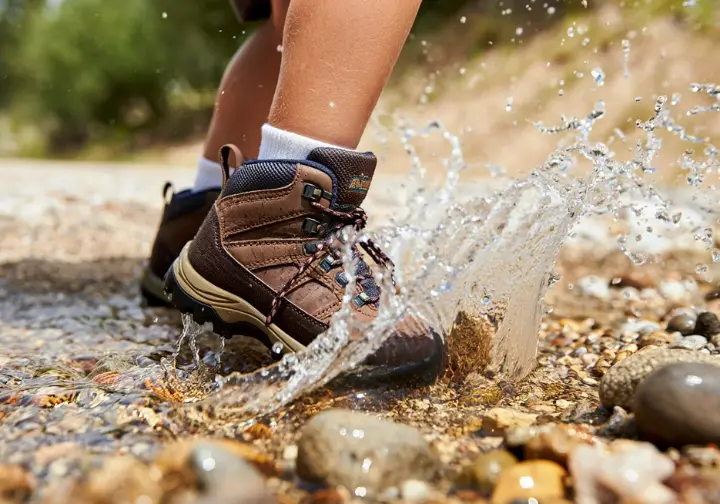
To build absolute trust and move beyond recycled marketing claims, we committed to a rigorous, hands-on evaluation process. Our primary allegiance is not to a brand or an affiliate link, but to you, the reader. Our singular goal is to arm you with objective, real-world data so you can make the best possible choice for your family’s safety and enjoyment on the trail.
Every boot in this guide was judged against the critical performance attributes detailed in our educational framework. We didn’t just look at feature lists; we focused intensely on real-world durability, the effectiveness of protective designs like heel & toe bumpers, all-day comfort, and true wet-weather performance. We wanted to know if a boot’s “waterproof” claim held up after the third stream crossing, not just the first.
To do this, we established a “Parent & Child Review Panel” composed of dedicated hiking families with several groups of kids ranging from 3 to 10 years old. Each pair of boots was field-tested for over 60 hours in a range of challenging and authentic conditions, from the perpetually muddy forests of the Puget Sound to the rocky, abrasive scrambles of the Colorado front range. This allowed us to see how the boots held up in the real world, not just a pristine lab environment.
Ultimately, we synthesized the detailed feedback from both our parent testers (who focused on durability, value, and ease of use) and our child testers (the ultimate judges of comfort and fun). The result of this exhaustive process is the clear, practical recommendations you see below, translating our data into solutions for your specific needs.
The Best Kids Hiking Boots of 2025: Our Top Picks
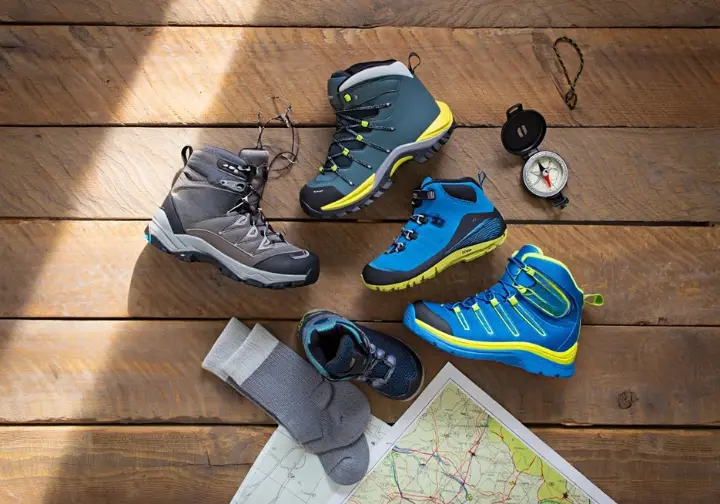
The following recommendations for the best childrens hiking boots are the direct result of our field testing, tailored to solve the specific needs of different hiking families. We’ve categorized our top picks to help you quickly identify the boot that best aligns with your priorities, whether you value out-of-the-box comfort, bombproof durability, or lightweight agility.
Best All-Around Workhorse
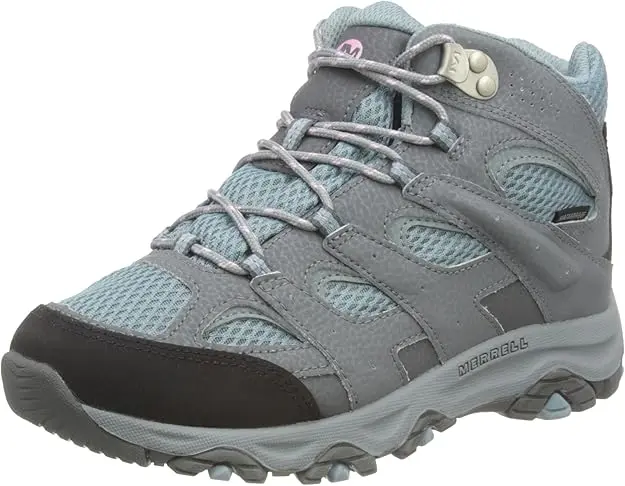
The Merrell Moab line has earned its “Mother of All Boots” reputation for a reason, and the kids’ version capably carries that legacy forward. It delivers legendary out-of-the-box comfort and a versatile design that makes it a reliable choice for everything from serious trail hikes to spontaneous playground adventures. Our testers confirmed its reputation for needing virtually no break-in period. The boot’s standout feature, especially for parents who struggle with fit, is the availability of both medium and wide widths, making it one of the most accommodating options on the market. Furthermore, the models featuring an “A/C” (Alternative Closure) system with a simple velcro strap are exceptionally easy for young children to manage themselves, fostering a welcome sense of independence.
PROS
- Exceptional out-of-the-box comfort
- Available in wide sizes for better fit
- Great for both hiking and everyday wear
- Velcro closure option is great for kids
CONS
- Waterproofing is unreliable in wet conditions
- Reports of declining long-term durability
Best Protective Fortress
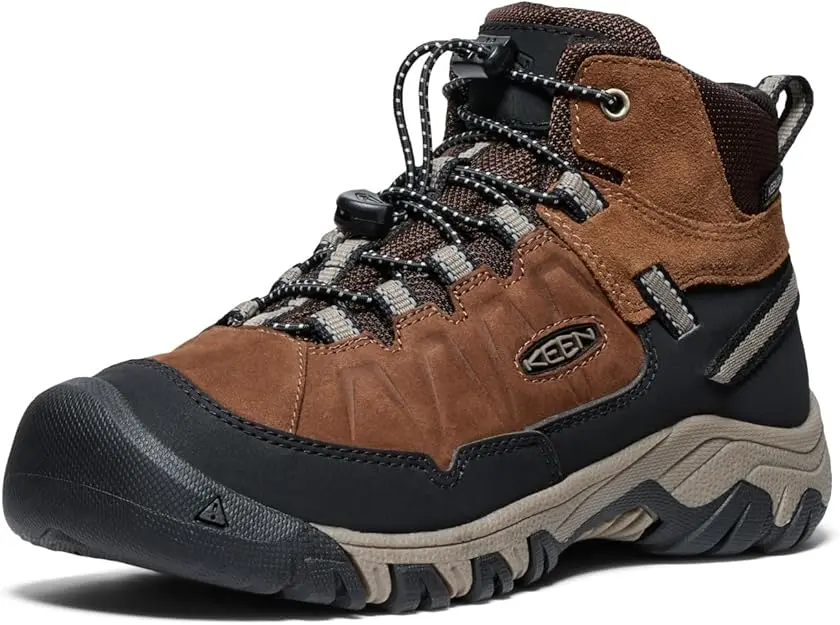
This is the boot for the child who is relentlessly tough on their gear during their outdoor adventures. The KEEN Targhee IV is built like a fortress, and our panel was immediately impressed by its robust construction and best-in-class protective features. Its hallmark is the iconic KEEN.PROTECT, an oversized rubber toe bumper that offers unparalleled protection against the inevitable impacts and abrasions of trail life. The durability is so exceptional—thanks to high-quality leather and reinforced construction—that parents on our panel consistently noted it felt like a boot that could genuinely be passed down to a younger sibling. The bungee cord lace system was another highlight, empowering even young children to achieve a secure fit on their own.
PROS
- Best-in-class durability and protection
- Excellent traction on varied terrain
- Easy-to-use bungee lacing system
- Generous and comfortable fit in toe box
CONS
- Can feel heavier and less flexible
- Not fully waterproof for deep submersion
- Can be difficult for some toddlers to put on
Final Considerations & Common Mistakes to Avoid
Choosing the right boot is the biggest step, but a few final considerations can make the difference between a good purchase and a perfect one. Navigating these common pitfalls will help you avoid frustration and get the most value out of your investment.
- Don’t Chase a Full Season of Growth: It’s tempting to buy boots that are excessively large to maximize their usable lifespan, but this is a mistake. A boot that is too big will allow the foot to slide, causing painful heel slip, instability, and blisters. Follow the “thumb’s width” rule—about a finger’s width of space past the longest toe—for sizing up, but no more. A secure fit is paramount for safety.
- Resist the “Hand-Me-Down” Habit (Unless…): Podiatrists generally advise against hand-me-downs because footwear molds to the unique shape of the first child’s foot. If economics make it a necessity, you must re-measure the second child’s foot to ensure a proper fit and, ideally, replace the insole to provide fresh, uncompressed footbeds.
- Invest in the System, Not Just the Boot: The world’s best boots will fail if paired with cotton socks. Cotton traps moisture against the skin, leading to blisters and discomfort. A quality pair of moisture-wicking merino wool or synthetic socks is a non-negotiable part of the footwear system.
- Check the Return Policy: Especially when buying online, ensure the retailer has a generous return policy. This allows you to have your child test the fit at home—walking up and down stairs and wearing them for an extended period—before committing to keeping them.
Frequently Asked Questions about Kids Hiking Boots
Do kids actually need hiking boots?
For casual walks on flat, even paths, comfortable sneakers are often sufficient. However, for rugged trails with uneven surfaces, rocks, and mud, the superior traction and protection of true hiking boots for kids provide a significant safety advantage for safe trail exploration.
What are the best hiking shoes for a 3-year-old?
For a toddler, the best toddler hiking shoes prioritize a very flexible sole to promote healthy foot development; options range from quality trail runners to sturdy, closed-toe sandals. The Salomon XA Pro V8 is an excellent option due to its flexibility and light weight, but always ensure a proper fit.
Should kids’ hiking boots be a size bigger?
Yes, it is wise to purchase boots about a half-size larger to accommodate for foot swelling during hikes and to provide a small amount of room for growth. Use the “thumb’s width” rule: there should be about a thumb’s width of space between your child’s longest toe and the end of the boot.
What is the difference between hiking boots and walking boots for kids?
The terms for these shoes/boots are often used interchangeably, but generally, “hiking boots” have more aggressive traction (deeper lugs) and a more rigid structure for stability on uneven terrain. “Walking boots” may be lighter and more flexible, designed for less demanding paths and general outdoor wear. The Merrell Moab series bridges this gap well.
Risk Disclaimer: Hiking, trekking, backpacking, and all related outdoor activities involve inherent risks which may result in serious injury, illness, or death. The information provided on The Hiking Tribe is for educational and informational purposes only. While we strive for accuracy, information on trails, gear, techniques, and safety is not a substitute for your own best judgment and thorough preparation. Trail conditions, weather, and other environmental factors change rapidly and may differ from what is described on this site. Always check with official sources like park services for the most current alerts and conditions. Never undertake a hike beyond your abilities and always be prepared for the unexpected. By using this website, you agree that you are solely responsible for your own safety. Any reliance you place on our content is strictly at your own risk, and you assume all liability for your actions and decisions in the outdoors. The Hiking Tribe and its authors will not be held liable for any injury, damage, or loss sustained in connection with the use of the information herein.
Affiliate Disclosure: We are a participant in the Amazon Services LLC Associates Program, an affiliate advertising program designed to provide a means for us to earn advertising fees by advertising and linking to Amazon.com. As an Amazon Associate, we earn from qualifying purchases. We also participate in other affiliate programs and may receive a commission on products purchased through our links, at no extra cost to you. Additional terms are found in the terms of service.









![Trek Budgeting: A Data-Backed Guide [+ Free Template] A trekker sits at a desk planning a trip budget on a laptop, with a stunning view of the Himalayan mountains visible through a window behind them.](https://thehikingtribe.com/wp-content/uploads/2025/07/00-trek-budgeting-data-backed-planning-100x75.webp)

